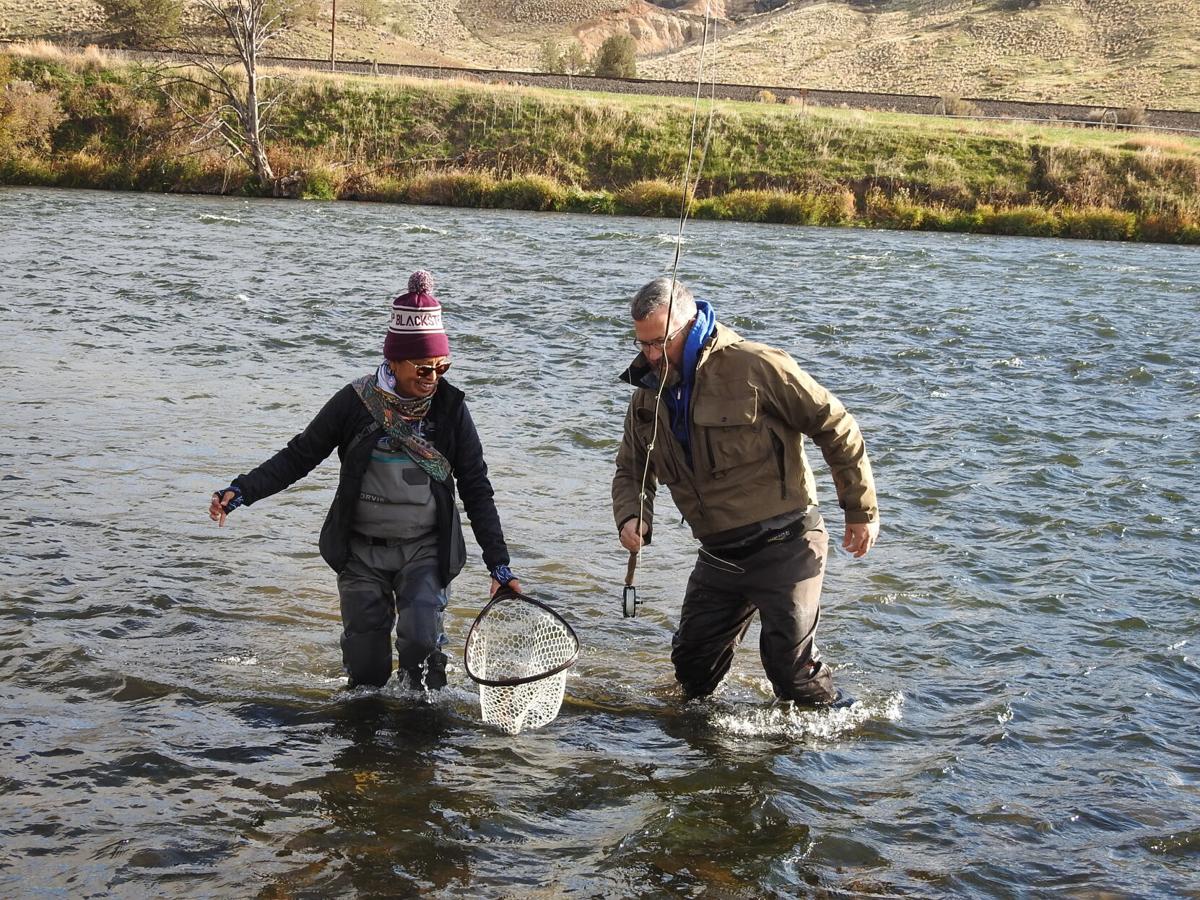This article was published on: 12/6/21 9:56 PM
By Gary Lewis
The reel balanced nicely against the 3-weight trout Spey rod in my hands and I stripped a couple feet of line off the arbor of the reel.
First, cast short, I reminded myself. Don’t wade in fast.
The only thing different is the rod is lighter, scaled-down from steelhead to trout. The move’s the same; the water the same.
A short cast, the length of the rod. Water swirled about my knees, the line straightened downstream.
We are not fishing for steelhead, I reminded myself. Rainbows want sculpin this time of year. Make them chase it.
I talk to myself a lot these days.
In a year when there are fewer steelhead in the river, we are chastened against fishing for sea-going rainbows. If we want to stand in the Deschutes and swing flies, we must target rainbows, Deschutes redsides. It is hardly a consolation prize. These are strong, worthy fish.
Upstream, Warm Springs tribal member and fishing guide Alysia Littleleaf coached my friend James Flaherty on the finer points of Spey fishing. Elke Littleleaf Kirk watched my dad and I from the sidelines.
In the back of our minds we wondered if steelhead would strike our scaled-down trout streamers — articulated sculpin imitations with conehead beads, Krystal Flash and strips of rabbit.
Downstream, dad hooked a rainbow that stripped line off his reel fast, and when the fish was all the way to the backing, it cart-wheeled well above the surface and threw the fly.
Back in Elke’s Suburban, we rumbled upstream to another corner where dad and James waded in while Elke and I walked up the old road bed to prospect a tailout at the bottom of an island.
This time, instead of swinging a sculpin pattern, Elke suggested I try a fly he had tied for me that morning. “I call it Gary’s Greenie Special,” he said. With the Greenie and another beadhead nymph in tandem, I plumbed the depths with several casts and, lengthening the leader beneath the indicator, saw the float bob. When the rod came tight, the fish blasted downstream into heavy current and for a few minutes, I thought it would beat me. But the tippet held and Elke slid the net under a 19-inch redside.
It was not fast fishing. In fact, it was like most late October, November and December days on the river when, after a cold snap, it is hard to get fish to grab.
But instead of targeting steelhead as we normally would this time of year, we were happy to scale down the rods, fish lighter lines and focus on feeding rainbows.
When the sun was overhead, I threw down a couple of bear hides and we sat on the shore and ate biscuit sandwiches cooked in my Camp Chef Dutch oven.
We should never forget, when the fishing is slow, at least we can eat good food.
Back on the water in early afternoon, we drove downstream to wade into some of my favorite water, accessible only on the Warm Springs Indian Reservation side.
Dad and James waded in first and when they had cast-swung-stepped their way far enough downstream, I waded in as high and as far in the fast water as I dared, again nymping with the Greenie while Alysia coached from the bank.
Steelheading in miniature. I used a 5-weight rod instead of a 7- or 8-weight. And when the float streaked sideways, I set the hook into one of the hottest rainbows I’ve hooked in a long time. Twice the 18-inch trout ran all the line out and I fought it well into the backing before it was ready to yield to the net.
When we had rested the run, James waded back in, and wielding the 3-weight Spey, he swung up a 13-inch redside on a rabbit strip sculpin imitation. It was his first fish on a Spey rod.
The next fish broke off the little Greenie. I grumbled all the way back to the bank and tied on a small sculpin imitation. A steelhead rolled downstream off the end of a branch. A big trout surfaced along a seam mid-river. A fish plucked at my fly. I let it turn before I lifted the rod toward the bank, but the fish was gone. I talked to myself again.
Much of the river banks from Warm Springs down to Macks Canyon and beyond have been stripped of the willows that used to provide shelter cover. Even the small tributaries lost their trees in devastating fires. It is a habitat crisis that will not be repaired in our lifetimes, although we can help.
“It is important to come together with coalitions to plant trees and rebuild the tree habitat here,” Alysia said. “There are very little tree roots and shade left. The fish are resilient. But we have to help them. And not just for a recreation fishery but for our people’s first foods to keep returning.”
Steelhead spend half their lives in saltwater. We know steelhead swim in the dangerous waters off the coasts of Japan and Kamchatka. Any discussion of what is going wrong with our fisheries has to take ocean conditions and foreign fishing into account.
Here at home the best way to get an idea of what needs to be done is to stand in the water with a fly rod. Read the water. Read the banks. Talk to other anglers. Talk to yourself.
I talk to myself more on the Lower Deschutes than anywhere else.




